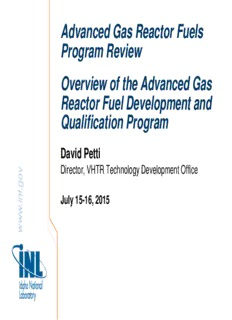
03 Petti AGR Fuels Program Review PDF
Preview 03 Petti AGR Fuels Program Review
Advanced Gas Reactor Fuels Program Review Overview of the Advanced Gas Reactor Fuel Development and Qualification Program David Petti v Director, VHTR Technology Development Office o g . l n July 15-16, 2015 i . w w w TRISO-Coated Particle Fuel is at the Heart of the High Temperature Gas Reactor Concept (provides technical basis for co-location with industrial facilities) Key aspects of TRISO Fuel: • German industrial experience demonstrated TRISO -coated particle fuel can be fabricated to achieve high-quality levels with very low defects • Fuel is very robust with no failures anticipated during irradiation and under accident conditions • Fuel form retains fission products resulting in a high degree of safety 2 HTGRs have Multiple Barriers to Radionuclide Release that Comprise the “Functional Containment” • Functional Containment is the collection of design selections that, taken together, ensure that: – Radionuclides are retained within multiple barriers, with emphasis on retention at their source in the fuel – Regulatory requirements and plant design goals for release of radionuclides are met at the Exclusion Area Boundary • Fuel Kernel Fuel Element • Fuel Particle Coatings • Matrix/Graphite • Helium Pressure Boundary • Reactor Building 3 TRISO Fuel is at the heart of the safety case for modular HTGRs • Fabrication of high-quality low-defect fuel is Results in low activity of fission achievable at industrial scale products in helium coolant – Defect fractions on the order of 10-5 – Process produces narrow distributions of fuel For the small level of defective attributes (standard deviation of thicknesses m particles, significant retention and densities are small) in fuel kernel, fuel matrix and r e – Process is stable and repeatable at industrial graphite T scale (batch to batch variation is very small) e • Robust irradiation performance inside design Results in low incremental c r service envelope release of fission products to u the helium coolants o – Designer assumes incremental failure fraction of 2x10-4 S Significant retention of metallic w – Performance is better than designer fission products in graphite and o assumption fuel matrix L • Robust accident performance inside design service envelope – Designer assumes incremental failure fraction Results in low incremental of 6x10-4 release of fission products – Performance is better than designer under accident conditions assumption 4 Objectives • Provide a fuel qualification data set in support of the licensing and operation of an HTGR – HTGR fuel performance demonstration and qualification comprise the longest duration research and development (R&D) task required for design and licensing – The fuel form is to be demonstrated and qualified for service conditions enveloping normal operation and potential accident scenarios • Support deployment of the HTGR for hydrogen, process heat, and energy production in the United States by reducing market entry risks posed by technical uncertainties associated with fuel production and qualification • Extend the value of DOE resources by using international collaboration mechanisms 5 Program Plan • Developed at start of the program • Complete listing of activities necessary to qualify UCO TRISO fuel for use in modular HTGRs • Full life-cycle cost and schedule used to guide program’s financial needs and establish key milestones • Updated annually to account for any new scope or changes based on R&D done to date 6 Approach • WBS established to coincide with key technical activities in the program not with each “campaign” AGR Fuel Qualification Director Petti Project QA Manager Support Simonds Bailey Fuel Fission Data Fabrication Irradiation PIE Performance Product Qualification Modeling Transport Marshall Davenport Demkowicz Lybeck Maki Vacant 7 History • Started in Summer 2002 • Past four years 2010-2014 • Initial plan developed in 2003 – AGR-1 PIE • Early days (2003-2006) – AGR-2 Irradiation – Re-establish fabrication capability – AGR-3/4 fuel fabrication (designed-to-fail fuel) – Fabrication studies – AGR-3/4 Irradiation – AGR-1 capsule design, assembly – Compacting scaleup and insertion – Preparations for AGR-2 and • Recent past (2006-2009) AGR-3/4 PIE – AGR-1 irradiation – Fuel fabrication for – Scale up coating qualification fuel (AGR-5/6/7) – AGR-2 coated particle fuel – Pre-conceptual design of fabrication AGR-5/6/7 capsule – Fuel acquisition strategy for NGNP project 8 Schedule Fuel Development and Qualification Calendar Year Activity Start Finish 2003 2004 2005 2006 2007 2008 2009 2010 2011 2012 2013 2014 2015 2016 2017 2018 2019 2020 2021 2022 2023 2024 2025 2026 AGR-1 - Shakedown Small Coater Fuel 5/1/2003 9/12/2015 AGR-1 Fuel Fabrication 5/1/2003 9/29/2006 AGR-1 Design and Assembly 5/1/2003 12/22/2006 AGR-1 Irradiation (Large B) 12/25/2006 11/6/2009 AGR-1 Test Train Cooldown 11/7/2009 2/28/2010 AGR-1 PIE and Safety Testing 3/1/2010 9/12/2015 AGR-2 Production Scale Coater Development 12/2/2006 7/20/2019 AGR-2 Fuel Fabrication 10/2/2006 4/9/2010 AGR-2 Design and Assembly 5/5/2008 6/11/2010 AGR-2 Irradiation (Large B) 6/23/2010 10/16/2013 AGR-2 Train Cooldown 10/17/2013 7/10/2014 AGR-2 PIE and Safety Testing 7/14/2014 7/27/2019 AGR-3/4 Fission Product Transport Data 5/8/2006 8/20/2019 AGR-3/4 Fuel Fabrication 5/3/2006 9/28/2011 AGR-3/4 Design and Assembly 3/2/2009 9/30/2011 AGR-3/4 Irradiation (NEFT) 12/14/2011 4/7/2014 AGR-3/4 Train Cooldown 4/7/2014 3/18/2015 AGR-3/4 PIE and Safety Testing 3/18/2015 8/20/2019 AGR-5/6/7 Fuel Qualification 10/1/2008 3/26/2024 AGR-5/6/7 Fuel Fabrication 10/1/2008 6/30/2016 AGR-5/6/7 Design and Assembly 5/1/2014 4/15/2017 AGR-5/6/7 Irradiation (NEFT) 6/27/2017 7/1/2020 AGR-5/6/7 Test Train Cooldown 7/18/2020 10/31/2020 AGR-5/6/7 PIE and Safety Testing 11/1/2023 3/26/2024 ATR Core Internals Changeout (no irradiation) 7/2/2020 12/31/2020 9 Documentation Tree Program Plan Fabrication Irradiation PIE Modeling Plan Specification Model Specification Development Fission Product Disassembly Design Data Mass Balance and Code Theory Package Measurements Metrology Manual Test Plan Thermal Physics Gamma Code User Ceramography Analysis Analysis Scan Manual Design and Design and As Run As Run IMGA and Pretest Safety Testing Radiography Predictions Uncertainty Gas Release Analysis (R/B) Posttest Data Qualification Data Qualification Predictions Final report Final Report 10
Description: